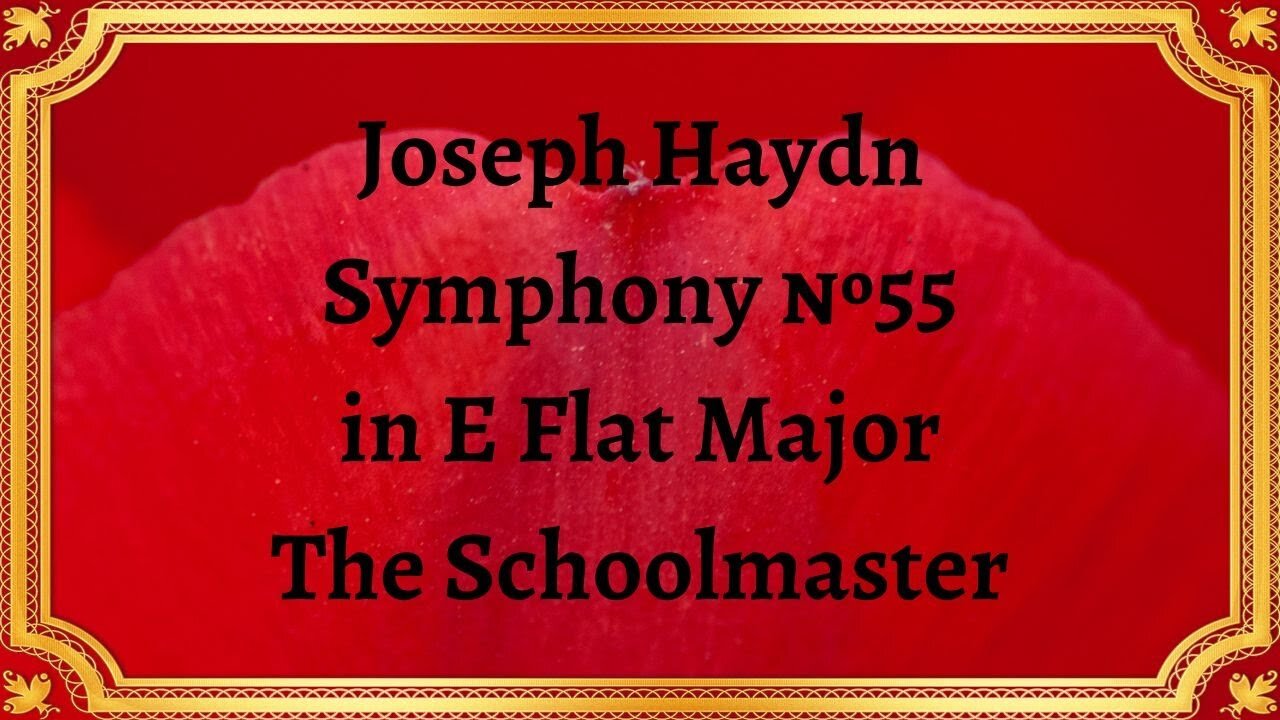Premium Only Content

Joseph Haydn Symphony №55 in E Flat Major The Schoolmaster
#JosephHaydn #SymphonyNo55 #EFlatMajor #TheSchoolmaster #ClassicalMusic #MusicalComposition #HaydnSymphony #OrchestralMusic #MusicAppreciation #MusicHistory #Composer #Musician #ClassicalPeriod #MusicEnsemble #InstrumentalMusic #Symphony #ConcertMusic #MusicPerformance #MusicEducation #MusicScholarship
Publication date 1951
Wiener Symphoniker; Hermann Scherchen
Joseph Haydn, one of the most influential composers of the classical era, crafted numerous symphonies that revolutionized the genre. Among his remarkable works, Symphony No. 55 in E Flat Major, famously known as "The Schoolmaster," stands as a testament to Haydn's artistic prowess and innovative musical language.
Composed in the late 18th century, Symphony No. 55 in E Flat Major reflects the pinnacle of Haydn's compositional style during the classical period. This era was marked by a shift from the elaborate Baroque style to a more refined and balanced musical language. Haydn's symphonies played a pivotal role in the development of this new musical aesthetic.
"The Schoolmaster" Symphony follows the traditional four-movement structure common in classical symphonies. The first movement, an allegro, introduces the listener to the main themes and establishes the tone of the composition. The second movement, a slow adagio, offers a contrasting emotional depth. The third movement, a minuet and trio, provides a lively and playful interlude. Finally, the fourth movement, a presto, brings the symphony to a thrilling and energetic conclusion.
Haydn's Symphony No. 55 showcases his mastery of thematic development. The opening movement presents a distinct and memorable melody that is skillfully expanded upon and explored throughout the symphony. Haydn's use of intricate and inventive counterpoint, along with unexpected harmonic twists, adds depth and complexity to the composition, captivating the listener's attention.
The nickname "The Schoolmaster" derives from the second movement of the symphony, which features a playful and rhythmic theme reminiscent of a teacher's cane striking the floor to gain the students' attention. This unique and whimsical element adds a touch of humor and character to the symphony, showcasing Haydn's ability to infuse his compositions with narrative elements.
Symphony No. 55 continues to captivate audiences and inspire musicians. With its balanced structure, inventive themes, and masterful orchestration, it represents a turning point in the evolution of symphonic music. Haydn's innovative use of musical devices in this symphony served as a precursor to the groundbreaking works of Beethoven and influenced the development of the symphonic form.
Conclusion:
Joseph Haydn's Symphony No. 55 in E Flat Major, "The Schoolmaster," stands as a testament to the composer's creativity and mastery of the classical symphonic style. Its meticulous structure, thematic development, and playful narrative elements make it a masterpiece of the genre. As we immerse ourselves in the symphony's captivating melodies and intricate harmonies, we gain a deeper appreciation for Haydn's contributions to classical music. Symphony No. 55 serves as a shining example of his genius, leaving an indelible mark on the rich legacy of symphonic composition.
You have the opportunity to support the channel https://destream.net/live/RadSiarAl/donate
-
 LIVE
LIVE
Dr Disrespect
4 hours ago🔴LIVE - DR DISRESPECT - TRIPLE THREAT CHALLENGE - EXTREME EDITION
4,475 watching -
 6:51
6:51
Chef Donny
2 hours agoMaking Omelets With Dave Portnoy | What's For Lunch
5.87K2 -
 3:53
3:53
SLS - Street League Skateboarding
5 days agoFrom ABQ to LA - Mariah Duran’s Journey | Kona Big Wave “Beyond The Ride” Part 2
6.85K1 -
 LIVE
LIVE
Mally_Mouse
19 hours agoLet's Yap About It - LIVE!
190 watching -
 16:47
16:47
Neil McCoy-Ward
8 hours ago"We've Never Seen Anything Like It!!!" (🇬🇧 Says Private Jet Pilot)
9.54K10 -
 LIVE
LIVE
G2G Gaming Channel
6 hours agoSmite&Fortnite, Chancletazo&Helmet . Same thing if you ask me!! #RumbleGaming
140 watching -
 1:28:06
1:28:06
Russell Brand
3 hours agoInside Trump’s Inauguration: Media Frenzy, Pardons, and Power Plays – SF524
154K77 -
 1:58:47
1:58:47
The Charlie Kirk Show
3 hours agoThe Bravest Presidential Action In Decades + Trump's Spiritual Rebirth | Sen. Mullin | 1.22.2025
139K46 -
 1:41:39
1:41:39
Matt Kim
16 hours agoThe Single Best Part of Trump's Inauguration | Matt Kim #137
35.7K6 -
 LIVE
LIVE
The Sufari Hub
2 hours agoWEDNESDAY GAMING SESH | Kompete & Fortnite & Minecraft - #RumbleGaming
48 watching